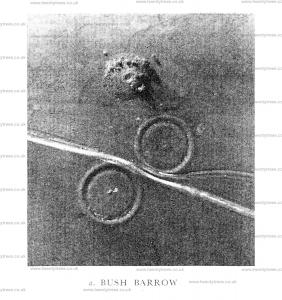Europe, British Isles, South-West England, Wiltshire, Stonehenge Landscape, Stonehenge Barrows, Normanton Down Barrows, Bush Barrow aka Normanton 158 aka Wilsford G5 [Map]
Bush Barrow aka Normanton 158 aka Wilsford G5 is in Normanton Down Barrows.
Bush Barrow aka Normanton 158 aka Wilsford G5 [Map] is a Bronze Age Round Barrow. In 1808 Bush Barrow aka Normanton 158 aka Wilsford G5 [Map] was excavated by William Cunnington. It contained a male skeleton with a collection of funerary goods that make it one of the richest burials in Britain. The grave goods include a large 'lozenge'-shaped sheet of gold, a sheet gold belt plate, three bronze daggers, a bronze axe, a stone macehead and bronze rivets.
All the following items are in the collection of [Map] and normally on display. The photographs and information is sourced from Devizes Museum website.
Bronze flanged axehead with traces of coarse cloth visible on the blade, found with a primary male inhumation (near the shoulders). Length 159 mm; width 67 mm; height 10 mm.
Gold lozenge-shaped breast plate made of thin gold covering a wooden plaque and decorated with four nested lozenge-shaped bands of four engraved lines each, the central one of which contains a chequered design with a zigzag design between the outer two bands, perforated at both ends, found with a primary male inhumation (over chest). Length 184 mm; width 156 mm; height 5 mm.
Polished oval macehead made from a fossil coral, perforated through the middle and containing traces of bronze. Found with a male inhumation (by right side) and possibly forming a sceptre. Length 100 mm; width 44 mm; height 40 mm.
Miniature gold lozenge-shaped ornament decorated with three nested lozenge-shaped lines (engraved), found with a primary male inhumation (by right side). Length 31 mm; width 19 mm; height 2 mm.
Copper dagger (Amorico British Class 1a) with a small tang, six rivets and parts of a wooden sheath adhering to the blade (originally with a handle inset with thousands of gold pins), found with a primary male inhumation (near right arm). Length 272 mm; width 80 mm; height 21 mm.
Gold belt hook decorated with four nested rectangular bands of three engraved lines, found with a primary male inhumation (near right arm). Length 77 mm; width 71 mm; height 16 mm.
Bronze dagger (the largest found in Wiltshire) with 6 rivet holes (three remaining) and parts of a wooden sheath adhereing to the blade, decorated with a rounded ridge. Length 330 mm; width 65 mm; height 20mm.
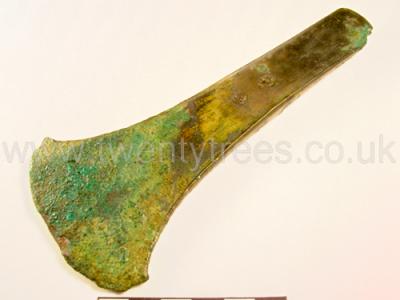
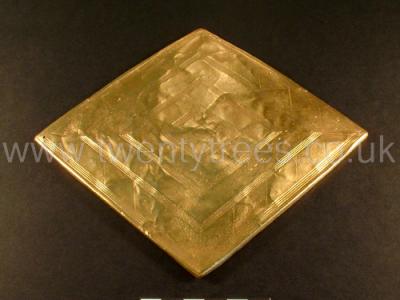
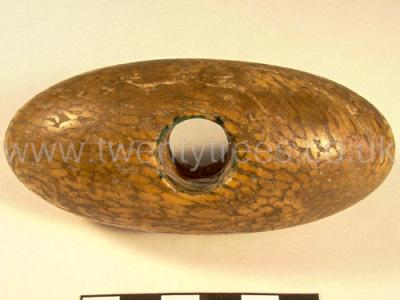
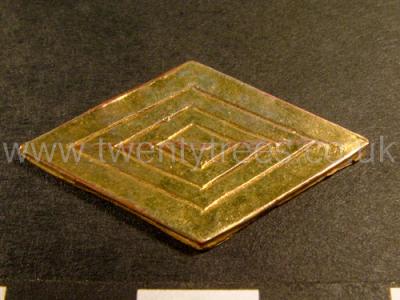
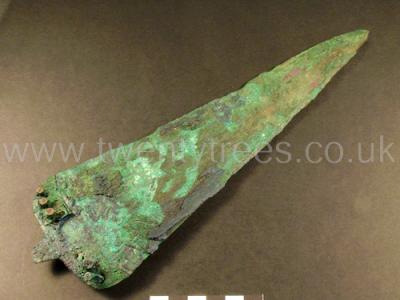
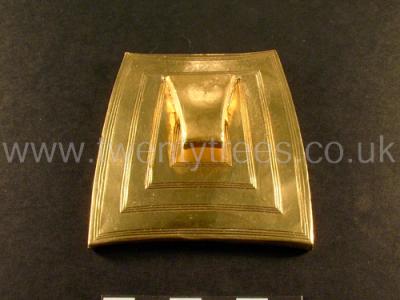
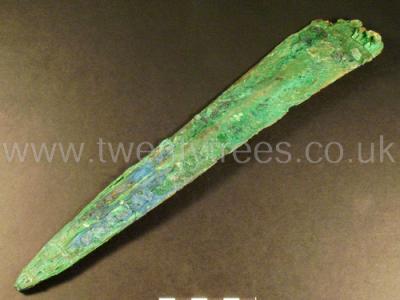
Stonehenge by William Stukeley. Table IX. Southern Prospect from Stonehenge. A. the barrow Ld Pembroke opened [Map]. B.B. [Map] those I opened. C. Bushbarrow [Map] D. a cavity in the vallum.
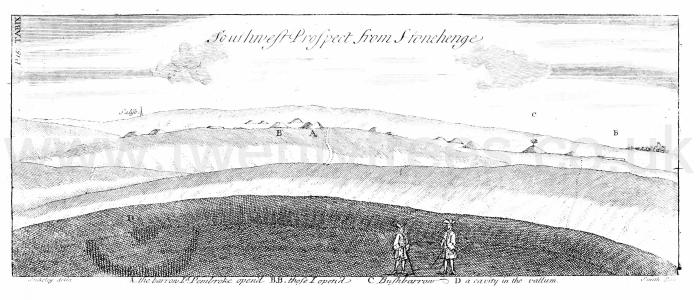
Stonehenge by William Stukeley. Table XXXIII. Prospect from Bushbarrow [Map]. a. Roundway Hill. b. Oldbury D. Stonehenge.
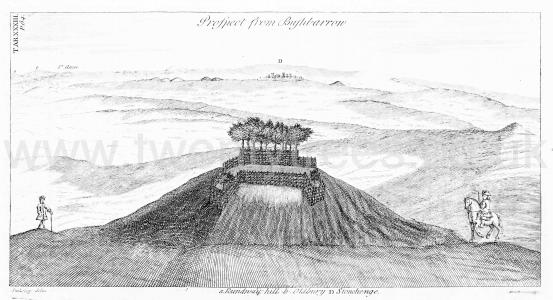
Stonehenge by William Stukeley. Table IX. Southern Prospect from Stonehenge. A. the barrow Ld Pembroke opened [Map]. B.B. [Map] those I opened. C. Bushbarrow [Map] D. a cavity in the vallum.

Colt Hoare 1812. No. 158 [Map]. Though Dr. Stukeley has given an engraving of this tumulus, under the title of BUSH BARROW, it does not appear that he ever attempted open it. It was formerly fenced round and planted with trees, and its exterior at present bears a very rough appearance from being covered with furze and heath. The first attempts made by Mr. Cunnington on this barrow proved unsuccessful, as also those of some farmers, who tried their skill in digging into it. Our researches were renewed ill September, 1808, and we were amply repaid for our perseverance and former disappointment. On reaching the floor of the barrow, we discovered the skeleton of a stout and tall man lying from south to north: the extreme length of his thigh bone was 20 inches. About 18 inches south of the head, we found several brass rivets intermixed with wood, and some thin bits of brass nearly decomposed. These articles covered a space of 12 inches or more; it is probable, therefore, that they were the mouldered remains of a shield. Near the shoulders lay the fine celt1 Tumuli Plate XXVI. No. 1, the lower end of which owes its great preservation to having been originally inserted in within a handle of wood. Near the right arm was a large dagger of brass, and a spear-head of the same metal, full thirteen inches long, and the largest we have ever found, though not so neat in its pattern as some others of an inferior size which have been engraved in our work. These were accompanied by a curious article of gold, which conceive had originally decorated the case of the dagger, Tumuli Plate XXVII, No. 1. The handle of wood belonging to this instrument, No. 2, exceeds any thing we have yet seen, both in design and execution, and could not he surpassed (if indeed equalled) by the most able workman of modern times. By the annexed engraving, you will immediately recognize the British zigzag, or the modern Vandyke pattern, which was formed with a labour and exactness almost unaccountable, by thousands of gold rivets, smaller than the smallest pin. The head of the handle, though exhibiting no variety of pattern, was also formed by the same kind of studding. So very minute, indeed, were these pins, that our labourers had thrown out thousands of them with their shovel, and scattered chem in every direction, before, by the necessary aid of a magnifying glass, we could discover what they were; but fortunately enough remained attached to the wood to enable us to develop the pattern. Beneath the fingers of the right hand lay a lance-head of brass, but so much corroded that it broke to pieces on moving. Immediately over the breast of the skeleton was a large plate of gold, Tumuli Plate XXVI. in the form of a lozenge, and measuring 7 inches by 6. It was fixed to a thin piece of wood, over the edges of which the gold was lapped: it is perforated at top and bottom, for the purpose, probably, of fastening it to the dress as a breast-plate. The even surface af this noble ornament is relieved by indented lines, checques, and zigzags, following the shape of the, outline, and forming lozenge within lozenge, diminishing gradually towards the centre. We next discovered, on the right side of the skeleton, a very curious perforated stone, some wrought articles of bone, many small rings of the same material, and another article of gold Plate XXVII, No 3, 4, 5. The stone is made out of a fossil mass of tubularia, and polished; rather of an egg form, or as a farmer who was present, observed, resembling the top of a large gimlet. It had a wooden handle, which was fixed into the perforation in the centre, and encircled by a neat ornament of brass, part of which still adheres to the stone. As this stone bears no marks of wear or attrition, I can hardly consider it to have been used as a domestic implement, and from the circumstance of its being composed of a mass of seaworms, or little serpents, I think we may not be too fanciful in considering it an article of consequence. We know, by history, that much importance was attached by the ancients to the serpent, and I have before had occasion to mention the veneration with which the glain nadrogth. was esteemed by the Britons; and my classical readers will recollect the fanciful story related by Pliny on this subject, who says, that the Druid's egg was formed by the scum of a vast multitude of serpents twisted and conjured up together. This stone, therefore, which contains a mass of or little serpents, might have been held in great veneration by the Britons, and considered of sufficient importance to merit a place amongst the many rich and valuable relicks deposited in this tumulus with the body of the deceased.
1. The word CELT has been applied to instruments of a very different form as well as composition, and has been written, engraved, and published concerning them. In the fifth volume of the Archæologia, we find a dissertation on them by Mr. Lort. accompanied by numerous engravings describing their different forms, some few of which resemble those that we have discovered; but one only is recorded a having been found in a Long barrow near Stonehenge by Dr. Stukeley, and rot recorded as a certainty. Much conjecture and debate have been employed by various authors respecting the original use of this instrument. Mr. Thoresby, in a letter to the celebrated antiquary Thomas Hearne, supposes them to have been heads of spears: or walking staves of the civilized Britons; but this opinion is rejected by Hearne, who thinks they were chissels used b the Romans for cutting and polishing stones. A curious inscription at Pola, in Istria, ascertains hat the word celtis denoted a chissel or graving tool, "Neque hic atramentum, vel papyrus, aut membrana ulla adhuc, sed malleolo et celie literatus silex, [Cruterus page 329]. Dr. Borlase also, in his Antiquities of Cornwall, page 281, has given an account of several brass Celts found in that county, together with an engraving. He supposes them to have been offensive weapons, and to have been made and used by the Romanized Britons. Dr. Stukeley attaches a degree of religious authority to them, by supposing that they were used by the Druids for cutting the mistletoe. These instruments differed in their construction, and in point of antiquity, l must give the priority of age to those discovered in our barrows, of which I am enabled to produce four specimens. The first engraved ia Tumuli Plate XXI is highly interesting, and shews the mode which the brass instrument was inserted in the handle. The second, engraved in Plate XXVI. is of a much larger size, but also had its handle; as well as two others engraved in subsequent plates, which, though smaller, resemble the others in form. I am obliged, from conviction, and from the strong evidence afforded by this handle, to differ from the learned antiquaries who have delivered their opinions on this subject. I cannot, with Mr. Thoresby and Dr. Borlase. suppose them to have been spear-heads, or offensive weapons; neither can I agree with the laborious antiquary, Thomas Hearne, in supposing them edge-tools for cutting stones, the metals of which they are formed are soft for such a purpose; neither can we find the edges furrowed and scratched by hard usage; nor can my antiquarian zeal and enthusiasm persuade me to coincide, in this instance, with the Druidical system of Dr, Stukeley. They appear to me to have been instruments used for domestic, not for mihitary, architectural, or purposes. These appear also to have been the first models, from which the pattern with sockets for the insertion of a handle was taken; for amongst the numerous specimens described by Mr. Lort in the Archæologia, not one of the latter pattern is mentioned as having been discovered in a barrow. As many similar instruments have been found in Gaul, and have been noticed by and Caylus, I cannot attribute the sole manufacture of them to Britain, but rather suppose they imported thither from the mother country on the continent; or perhaps the art of making them might have been introduced. One circumstance, I think, appears evident and conclusive viz. that the earliest pattern, and which probably gave rise to the larger and more ornamented one, was that described in four instances as having been discovered amongst other sepulchral deposits in British tumuli. The celts of flint, engraved in Tumuli PlateS V, VI. were evidently used for chipping stone or other materials, of which I can adduce a curious proof, by the circumstances attending discovery of one of these articles, which is now in my possession. Some workmen in cutting a canal, near Stockbridge, found several of these flint Celts dispersed about the soil, and deposited near the rude trunk af a tree, which was intended to have been fashioned by their means into a boat or canoe.
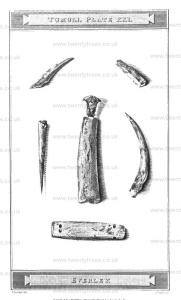
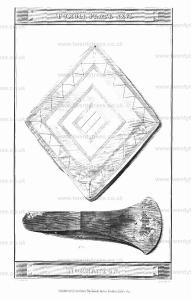
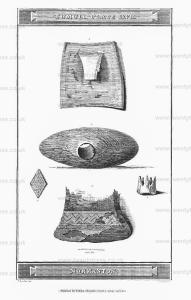
Wiltshire Archaeological Magazine 1907 V35 Pages 1-20. It is just a hundred years ago since the last recorded find of gold in a Bronze Age barrow in Wiltshire1, and the present one makes only the eighth similar find in the county, while in the whole of the rest of England and Wales there have been scarcely as many more. Five of the gold-bearing barrows were on Salisbury Plain - one close to its edge at Upton Lovel in the valley of the Wyly, and one at Mere in the extreme west of the county, about eight miles in a straight line from Upton Lovel2. All these were in South Wilts, and Dr. Thurnam remarks "no objects of the precious metal are found in the barrows in North Wilts." This find at Manton seems to be the first exception to the rule.
Note 1. Upton Lovel Golden Barrow, Hoare and Cunnington, 1803, re-opened, with further finds, in 1807.
Note 1. Upton Lovel Golden Barrow, burnt interment, Ancient Wilts, p. 202;
Note 2-Normanton barrow 155, burnt, ibid, p. 201;
Note 3-Normanton, barrow 156, unburnt, ibid, p. 202;
Note 4-Normanton Bush Barrow [Map], 158, unburnt, ibid, unburnt, ibid p. 202;
Note 5. Mere Down, unburnt, ibid, p. 44;
Note 6-Lake, barrow 21, unburnt, ibid, p. 213;
Note 7. Stonehenge barrow, burnt, Stukeley's "Stonehenge, pp. 44-62;
Note 8-Manton.
Although all these golden barrows have striking points of resemblance to each other, and doubtless belong to the same people and period, there seems to be no kind of rule as to the mode of burial, three being by cremation and five by inhumation.
Wessex from the Air Plate 33a. Bush Barrow [Map]
